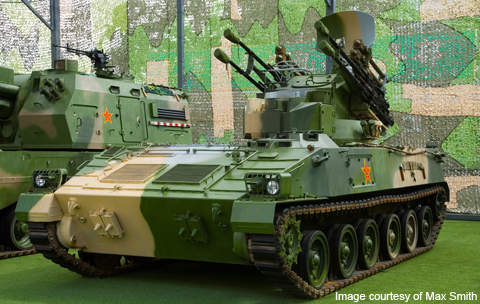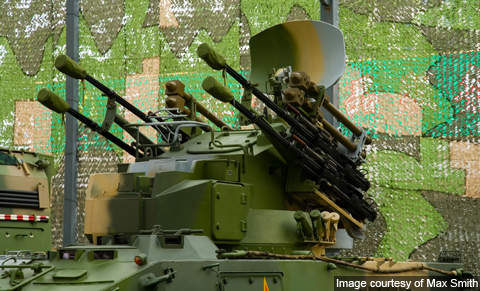The PGZ95 (Type 95) 25mm self-propelled anti-aircraft artillery (SPAAA) system.
The PGZ95 (Type 95) self-propelled anti-aircraft gun was designed by the Northwest Institute of Mechanical & Electrical Engineering for People’s Liberation Army Ground Force (PLAGF).
The PGZ95 was first demonstrated in 1999 during a military parade in Beijing. It was offered to overseas customers by the state-owned enterprise China North Industries Corporation (NORINCO), but no orders were received.
PGZ95 anti-aircraft artilllery system development
Development of the PGZ95 commenced in the mid 1980s. The system was developed as a Chinese equivalent of the Russian ZSU-23-4M4 Shilka.
PGZ95 is believed to have been benefited from the Italian Sidam 25mm SPAAG system as China acquired a Sidam turret in the mid 1980s for evaluation. The Type 95 is more capable than the former Chinese SPAAG systems. The 25mm cannon of the vehicle was based on the Type 87 25mm towed anti-aircraft gun.
Design and features
The hull is mounted on a tracked armoured chassis. The vehicle can accommodate a driver, a commander and a gunner. The commander is seated behind the driver who sits on the left side of the vehicle.
Both are provided with a raised hatch and three vision blocks. The engine is located forward of the vehicle, while a one-man turret is fitted on the rear of the hull.
Observation and fire-control
An electro-optic director (EOD) fitted in front of the turret consists of a TV, infrared tracking cameras and a laser rangefinder. The EOD feeds data to the onboard fire-control computer. The TV tracker has a tracking range of 6km while the infrared tracking camera has a maximum range of 5km. The laser rangefinder has a maximum range of 5.5km with an accuracy of +/- 5m.
The onboard computer calculates the weapon-laying data when the gunner opens fire on the target. The gunner is also provided with a joystick for shooting weapons at the target. The CLC-1 S-band low altitude target search radar fitted on the roof of the armament turret has a detection range of 11km. The radar antenna above the turret can be folded down frontward during the journey.
Armament
The PGZ95 is armed with four 25mm calibre guns, of which two are mounted on each side of the turret. Each canon has a firing rate of 600-800 rounds a minute per barrel. Storage is provided for around 1,000 rounds of 25mm ammunition. An automatic loading system reloads the guns.
The 25mm gun is used against ground targets and can destroy most of the light armoured vehicles. It can also engage aircraft and helicopters flying at an altitude of 2,000m.
The vehicle is also armed with four QW-2 short-range surface-to-air missiles. QW-2 can engage the airborne targets within the range of 6km. A set of four smoke grenade launchers are mounted either side of the lower part of the turret.
Self-protection
The hull and the turret are made of high hardness armour steel. The vehicle can withstand small arms fire and shell splinters.
Command vehicle
The PGZ95 SPAAA forms a complete mobile air-defence system along with a battery command vehicle. The command vehicle also uses similar chassis but features a raised superstructure at the rear hull for increased internal space. The vehicle can control six to eight SPAAA systems.
The command vehicle is equipped with CLC-2 PD surveillance radar. The radar sends data to the data processing system, distributing the target information among the individual SPAAG units.
The onboard communications equipment transmits the data in digital form for up to 15km through a standard radio. A navigation system and an auxiliary power unit are also installed in the vehicle.
The commander is seated to the rear of the driver. A manually operated 12.7mm anti-aircraft machine gun is mounted on the vehicle. The forward part of the raised superstructure is fitted with four smoke grenade launchers.
A PGZ95 battery includes six SPAAA systems, a battery command vehicle, a battery testing vehicle, a power supply vehicle and three ammunition carriers. All the vehicles are mounted on the same 6×6 cross-country truck chassis.







